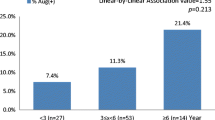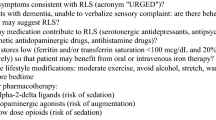Opinion statement
Augmentation is the main complication of long-term dopaminergic treatment of restless legs syndrome (RLS). Although augmentation was first described in 1996 and is characterized by an overall increase in severity of RLS symptoms (earlier onset of symptoms during the day, faster onset of symptoms when at rest, spreading of symptoms to the upper limbs and trunk, and shorter duration of the treatment effect), precise diagnostic criteria were not established until 2003. These criteria were updated in 2007 to form a new definition of augmentation based on multicenter studies. Augmentation should be differentiated from early morning rebound, natural progression of the disease, tolerance, and neuroleptic-induced akathisia. Treatment strategies will depend on the degree of clinical significance but will be based on the use of longer-acting drugs and a reduction or substitution of the dopaminergic agents. The most effective preventive measure is to keep the dose of the dopaminergic medication as low as possible, ensuring that it does not exceed the dose recommended by regulatory authorities. RLS augmentation needs to be treated only if it is clinically relevant—that is, if it has a significant impact on the patient’s daily activities. Mild cases should be followed closely, however. In severe cases, a change of treatment (sometimes even within the same class of drugs) can be effective, although before taking this step, it should be verified that all factors that may affect augmentation (changes in lifestyle, iron deficiency, serotonin reuptake inhibitors) have been excluded.
Similar content being viewed by others
References and Recommended Reading
von Scheele C, Kempi V: Long-term effect of dopaminergic drugs in restless legs. A 2-year follow-up. Arch Neurol 1990, 47:1223–1224.
Silber MH, Girish M, Izurieta R: Pramipexole in the management of restless legs syndrome: an extended study. Sleep 2003, 26:819–821.
Happe S, Trenkwalder C: Role of dopamine receptor agonists in the treatment of restless legs syndrome. CNS Drugs 2004, 18:27–36.
Allen RP, Earley CJ: Augmentation of the restless legs syndrome with carbidopa/levodopa. Sleep 1996, 19:205–213.
Allen RP, Picchietti D, Hening WA, et al.: Restless legs syndrome: diagnostic criteria, special considerations, and epidemiology. A report from the restless legs syndrome diagnosis and epidemiology workshop at the National Institutes of Health. Sleep Med 2003, 4:101–119.
Garcia-Borreguero D, Allen RP, Kohnen R, et al.: Diagnostic standards for dopaminergic augmentation of restless legs syndrome: report from a World Association of Sleep Medicine-International Restless Legs Syndrome Study Group consensus conference at the Max Planck Institute. Sleep Med 2007, 8:520–530.
Allen RP, Walters AS, Montplaisir J, et al.: Restless legs syndrome prevalence and impact: REST general population study. Arch Intern Med 2005, 165:1286–1292.
Walters AS, LeBrocq C, Dhar A, et al.: Validation of the International Restless Legs Syndrome Study Group rating scale for restless legs syndrome. Sleep Med 2003, 4:121–132.
Garcia-Borreguero D: Augmentation: understanding a key feature of RLS. Sleep Med 2004, 5:5–6.
Collado-Seidel V, Kazenwadel J, Wetter TC, et al.: A controlled study of additional sr-L-dopa in L-dopa-responsive restless legs syndrome with late-night symptoms. Neurology 1999, 52:285–290.
Guilleminault C, Cetel M, Philip P: Dopaminergic treatment of restless legs and rebound phenomenon. Neurology 1993, 43:445.
Walters AS, Hening W, Rubinstein M, Chokroverty S: A clinical and polysomnographic comparison of neurolepticinduced akathisia and the idiopathic restless legs syndrome. Sleep 1991, 14:339–345.
Inami Y, Horiguchi J, Nishimatsu O, et al.: A polysomnographic study on periodic limb movements in patients with restless legs syndrome and neuroleptic-induced akathisia. Hiroshima J Med Sci 1997, 46:133–141.
Lipinski JF, Hudson JI, Cunningham SL, et al.: Polysomnographic characteristics of neuroleptic-induced akathisia. Clin Neuropharmacol 1991, 14:413–419.
Trenkwalder C, Benes H, Grote L, et al.: Cabergoline compared to levodopa in the treatment of patients with severe restless legs syndrome: results from a multi-center, randomized, active controlled trial. Mov Disord 2007, 22:696–703.
Earley CJ, Allen RP: Pergolide and carbidopa/levodopa treatment of the restless legs syndrome and periodic leg movements in sleep in a consecutive series of patients. Sleep 1996, 19:801–810.
Silber MH, Shepard JW Jr, Wisbey JA: Pergolide in the management of restless legs syndrome: an extended study. Sleep 1997, 20:878–882.
Stiasny K, Wetter TC, Winkelmann J, et al.: Long-term effects of pergolide in the treatment of restless legs syndrome. Neurology 2001, 56:1399–1402.
Ferini-Strambi L: Restless legs syndrome augmentation and pramipexole treatment. Sleep Med 2002, 3(Suppl):S23–S25.
Winkelman JW, Johnston L: Augmentation and tolerance with long-term pramipexole treatment of restless legs syndrome (RLS). Sleep Med 2004, 5:9–14.
Benes H, Heinrich CR, Ueberall MA, Kohnen R: Longterm safety and efficacy of cabergoline for the treatment of idiopathic restless legs syndrome: results from an open-label 6-month clinical trial. Sleep 2004, 27:674–682.
Stiasny-Kolster K, Benes H, Peglau I, et al.: Effective cabergoline treatment in idiopathic restless legs syndrome. Neurology 2004, 63:2272–2279.
Högl B, Garcia-Borreguero D: Similar incidences of augmentation during 26 weeks of double-blind pramipexole treatment for restless legs syndrome in comparison to placebo [abstract]. Presented at the 61st Annual Meeting of the American Academy of Neurology. St Paul, MN: April 25–May 2, 2009.
Garcia-Borreguero D, Grunstein R, Sridhar G, et al.: A 52-week open-label study of the long-term safety of ropinirole in patients with restless legs syndrome. Sleep Med 2007, 8:742–752.
Benes H, Garcia-Borreguero D, Allen R, Kohnen R: Augmentation in long-term therapy of the restless legs syndrome with transdermal rotigotine-a retrospective systematic analysis of two large open-label 1-year trials. Sleep 2009, 32:A307.
Earley CJ, Allen RP: Restless legs syndrome augmentation associated with tramadol. Sleep Med 2006, 7:592–593.
Vetrugno R, La Morgia C, D’Angelo R, et al.: Augmentation of restless legs syndrome with long-term tramadol treatment. Mov Disord 2007, 22:424–427.
Garcia-Borreguero D, Kohnen R, Högl B, et al.: Validation of the Augmentation Severity Rating Scale (ASRS): a multicentric, prospective study with levodopa on restless legs syndrome. Sleep Med 2007, 8:455–463.
Garcia-Borreguero D, Allen RP, Benes H, et al.: Augmentation as a treatment complication of restless legs syndrome: concept and management. Mov Disord 2007, 22(suppl):S476–S484.
Trenkwalder C, Hening WA, Montagna P, et al.: Treatment of restless legs syndrome: an evidence-based review and implications for clinical practice. Mov Disord 2008, 23:2267–2302.
Trenkwalder C, Högl B, Benes H, Kohnen R: Augmentation in restless legs syndrome is associated with low ferritin. Sleep Med 2008, 9:572–574.
Allen R: Dopamine and iron in the pathophysiology of restless legs syndrome (RLS). Sleep Med 2004, 5:385–391.
Davis BJ, Rajput A, Rajput ML, et al.: A randomized, double-blind placebo-controlled trial of iron in restless legs syndrome. Eur Neurol 2000, 43:70–75.
Author information
Authors and Affiliations
Corresponding author
Rights and permissions
About this article
Cite this article
Williams, AM., Garcia-Borreguero, D. Management of restless legs syndrome augmentation. Curr Treat Options Neurol 11, 327–332 (2009). https://doi.org/10.1007/s11940-009-0036-2
Published:
Issue Date:
DOI: https://doi.org/10.1007/s11940-009-0036-2




